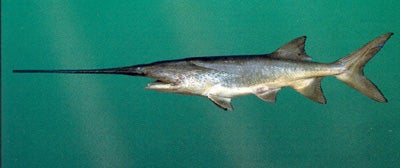SCIENTIFIC NAME:
Polyodon spathula
CHARACTERISTICS:
This fish’s long, paddle-shaped snout accounts for about one-third of its total body length. The snout helps to stabilize the fish as it swims, and it also contains specialized cells that assist in detecting the plankton swarms upon which this species feeds. The skin is smooth. Small individuals are pink on the back and white on the venter; for larger individuals around 10 to 12 inches, the body color changes to bluish gray on the back and cream on the venter. The eyes are tiny compared to the rest of the head and body. On the underside of the snout are two minute barbels in front of a large, toothless mouth. When viewed through the mouth, the gills are large and show the many closely spaced filaments that trap microscopic food. On each side, a gill cover extends posteriorly, ending in a long, pointed flap. The skeleton is composed of cartilage rather than bone. The end of the verterbral column extends into the upper lobe of the heterorcercal tail, much as a shark’s does.
ADULT SIZE:
3.9 to 5.9 ft (1.2 to 1.8 m).
STATE RECORD:
a list of the State Record Freshwater Fish.
Paddlefish occur primarily below the Fall Line in the Mobile basin. They are absent in our coastal rivers.
HABITAT AND BIOLOGY:
Paddlefish are generally found in open water, but we have collected individuals as long as 3 to 4 feet in relatively small streams, such as Isaac Creek (Monroe County), Chickasaw Creek (Mobile County), and Three Rivers Creek (Washington County). A migratory species, paddlefish congregate below dams to spawn during March and April. Spawning between one female and several males is believed to occur in open water. Floating downstream with the current, eggs drift to the bottom and stay there until hatching. Newly hatched individuals grow rapidly, reaching 12 to 14 inches by the end of their first year. Paddlefish are long-lived. Examinations of growth rings on the dentary bones indicate life spans of 20 to 30 years.
ORIGINAL DESCRIPTION:
Walbaum described the paddlefish in 1792.
ETYMOLOGY:
Polyodon means many teeth, referring to the numerous gill rakers.
Spathula means spatula, referring to the paddle-shaped snout.
The copyrighted information above is from Fishes of Alabama and the Mobile Delta.
Additional Information:
The US Geological Survey has an interesting page on paddlefish, including a fact sheet.
- Due to a sharp decline in paddlefish numbers during the 1980's, Alabama prohibited the harvest of paddlefish in all public waters for many years. As a result of that protection, paddlefish populations have recovered in several rivers of the state. A recent study of the paddlefish population of the Alabama River determined that the numbers of paddlefish had reached a level where a controlled commercial harvest is sustainable. The Division of Wildlife and Freshwater Fisheries opened a limited fishery for the commercial harvest of paddlefish beginning in 2013. This commercial harvest was suspended after the 2018 season.
- The eggs of paddlefish make excellent caviar.
- Paddlefish are an important component of many commercial fisheries in states that allow harvest of this species.
- Paddlefish need gravel and consistent water flow to successfully spawn.
- Paddlefish have been recorded moving over 100-miles in the Alabama River System and have moved upstream over Claiborne Lock and Dam during high water events.
- Bighead carp, a non-native species, are present in Alabama and can compete for food with juvenile paddlefish.
- Paddlefish are easily recognized by their long, paddle-shaped snout and their lack of plates or scales.
- Paddlefish are often called spoon-billed catfish by anglers because their skin resembles that of a catfish.
- Paddlefish eat microscopic plants and animals (plankton).
- The nearest relative of the paddlefish lives in China.
- The skeleton of a paddlefish is cartilage rather than bone.






